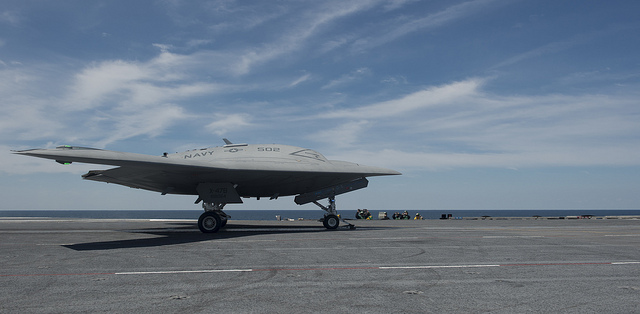The decline in USAF fighter capability and the unmanned future
Posted By Malcolm Davis on January 8, 2014 @ 12:30
In a recently reprinted Strategist post, Peter Layton examines the challenges facing the USAF [2] in sustaining adequate numbers of capable fighter aircraft in an era of financial austerity and indeterminate threat. His excellent analysis closes with a number of important questions regarding the future of the manned fighter aircraft, and the implications of declining USAF fighter numbers relative to other powers. He also raises the significance of unmanned platforms as the next logical successor to manned fighter aircraft.
In an uncontested airspace and with secure command and control data links, the employment of unmanned air vehicles (UAVs) to conduct intelligence, surveillance, targeting and reconnaissance (ISTAR) and then strike with precision weapons is a valuable capability, though one which generates a range of challenging legal and ethical issues. What’s far less certain is the ability of UAVs to be effective in a highly contested airspace, where speed, stealth and manoeuvrability matter. This calls for something much more capable—the unmanned combat air vehicle (UCAV). The ‘unmanned future’ that Peter Layton points to remains uncertain, and current developmental programs aren’t emphasising the types of capabilities necessary if a UCAV is to survive in heavily contested airspace.
The current state of development of UCAVs—epitomised by the Northrop Grumman X-47B UCAS-D [3]—doesn’t imply that manned fighters are in danger of obsolescence any time soon. Early hopes of stealthy and supersonic UCAVs performing 20g break turns in a dog-fight are yet to appear in anything other than bad Hollywood movies. All are subsonic, have limited range, remain vulnerable to ground-based air defences and modern fighter aircraft, and have vulnerable command and control data-links which can be jammed, or even hacked, as Iran claims it successfully did to capture a highly secret USAF RQ-170 reconnaissance UAV in 2011 [4]. So replacing the manned fighter with unmanned systems is some way off, which reinforces the importance of the question posed by Layton—‘should America’s close allies be concerned by the evident decline in US fighter capabilities, and what implications does this have for ADF force structure and capabilities?’
The key challenge facing the US Air Force in Asia is projecting power and presence in an A2AD environment that’s emerging as a direct result of China’s rapidly growing counter-intervention capabilities. UCAVs won’t be able to control the skies for many years, and current USAF manned fighters are all relatively short-ranged in comparison to the physical size of the East Asian operational theatre, and so depend on either forward bases which are vulnerable to long-range missiles, or aircraft carriers, which are coming under threat from a suite of counter-intervention systems, including China’s DF-21D anti-ship ballistic missile (ASBM). In this sense, the declining size of the USAF fighter force noted by Layton amplifies the risks of the US being unable to project military power into East Asia, increasing the danger faced by its regional allies including Australia, in a future military crisis with China. It’s a simple matter of range and numbers.
Does this challenge imply a case for reconsidering the ADF’s future air combat capability, based around the F-35 Joint Strike Fighter? The recent CSBA report ‘Gateway to the Indo-Pacific’ [5] noted that one of Australia’s greatest assets is its strategic depth, and they suggest it could be a ‘supportive sanctuary’ for allied (US) combat systems in the event of war with China. However China would be very unlikely to allow the US to use Australia as a secure sanctuary unmolested, and the paper presents a map showing much of the ADF’s military infrastructure in the North and North-west would be vulnerable to Chinese aircraft or submarine launched missile attack. It would be up to the ADF to secure Australian airspace against the sorts of long-range air-attack or missile attack options open to China suggested by the CSBA report.
In considering future force structure options for the ADF in the lead up to the 2015 Defence White Paper, the possibility of a Chinese missile-threat against US forces operating from Australian bases in the North and West, launched from aircraft and forward deployed submarines, needs to be considered for its implications regarding the size and capability of the ADF’s future fighter force, as well as for supporting forces such as Airborne Early Warning, long-range air surveillance, and command and control. Serious risks in terms of project delays and operating cost, as well as concerns over operational capability in comparison with emerging adversary fifth generation and ‘four+’ generation combat aircraft aside, the F-35 Joint Strike Fighter currently seems to be ‘the only game in town’ in terms of future RAAF options. But are 100 aircraft sufficient, especially if UCAVs are clearly not a short-term solution? Might more advanced ground-based air defence capabilities, such as long-range SAMs, be a means of protecting vital facilities from missile attack?
These force structure development questions allude to a more significant question of strategy facing the Coalition in shaping its Defence Policy. The strategic outlook is getting worse—not better. The challenge posed by China in particular needs to taken much more seriously in the next Defence White Paper than it was in the last edition. That implies getting serious about strategic policy planning by adequately funding Defence, rather than seeing it as a convenient piggy bank in tough financial times.
Malcolm Davis is assistant professor in International Relations and post-doctoral research fellow in China-Western Relations at Bond University. Image courtesy of Flickr user Official U.S. Navy Imagery [6].
Article printed from The Strategist: https://www.aspistrategist.org.au
URL to article: https://www.aspistrategist.org.au/the-decline-in-usaf-fighter-capability-and-the-unmanned-future/
URLs in this post:
[1] Image: http://www.aspistrategist.org.au/wp-content/uploads/2014/01/8739265550_fb0eaebacd_z.jpg
[2] examines the challenges facing the USAF: http://www.aspistrategist.org.au/a-strategist-retrospective-the-declining-usaf-tactical-fighter-fleet/
[3] Northrop Grumman X-47B UCAS-D: http://www.northropgrumman.com/Capabilities/X47BUCAS/Pages/default.aspx
[4] Iran claims it successfully did to capture a highly secret USAF RQ-170 reconnaissance UAV in 2011: http://www.airforcetimes.com/article/20111209/NEWS/112090311/Iran-s-captured-RQ-170-How-bad-is-the-damage-
[5] CSBA report ‘Gateway to the Indo-Pacific’: http://www.csbaonline.org/publications/2013/11/gateway-to-the-indo-pacific-australian-defense-strategy-and-the-future-of-the-australia-u-s-alliance-2/
[6] Official U.S. Navy Imagery: http://www.flickr.com/photos/usnavy/8739265550/
Click here to print.
